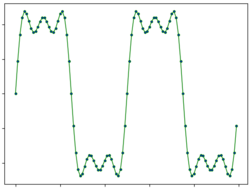Physics:Harmonic spectrum
From HandWiki

A harmonic spectrum is a spectrum containing only frequency components whose frequencies are whole number multiples of the fundamental frequency; such frequencies are known as harmonics. "The individual partials are not heard separately but are blended together by the ear into a single tone."[1]
In other words, if is the fundamental frequency, then a harmonic spectrum has the form
A standard result of Fourier analysis is that a function has a harmonic spectrum if and only if it is periodic.
See also
- Fourier series
- Harmonic series (music)
- Periodic function
- Scale of harmonics
- Undertone series
References
 |


